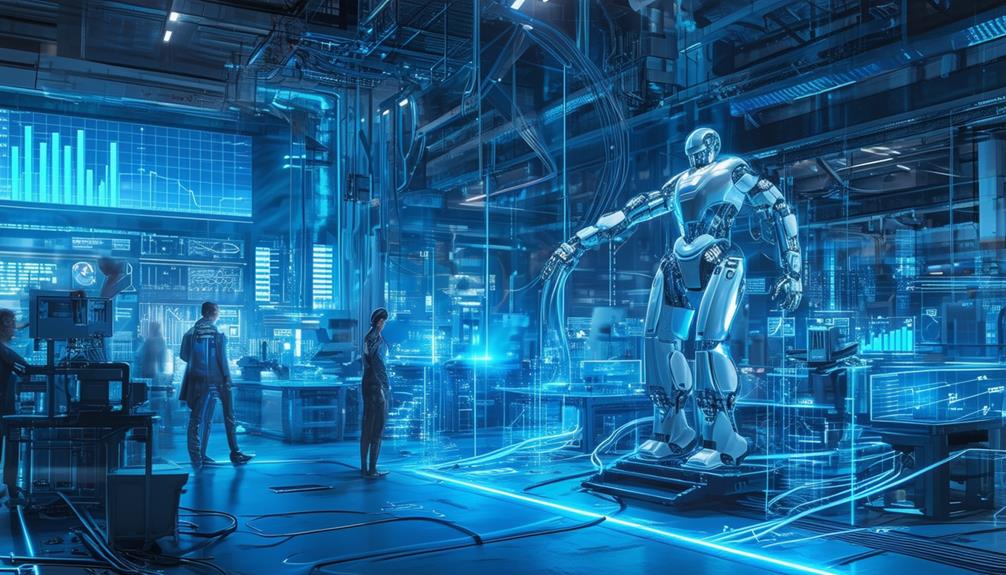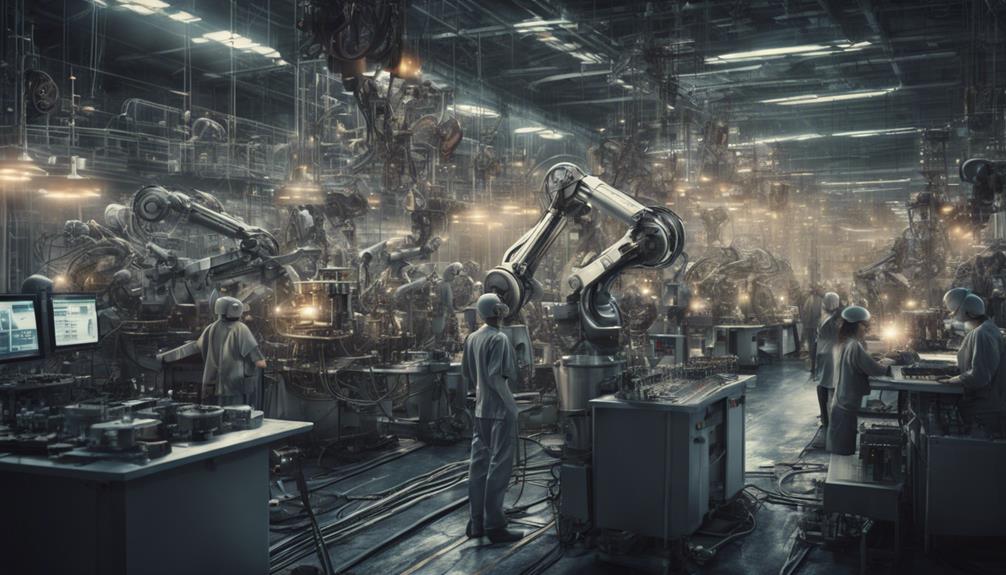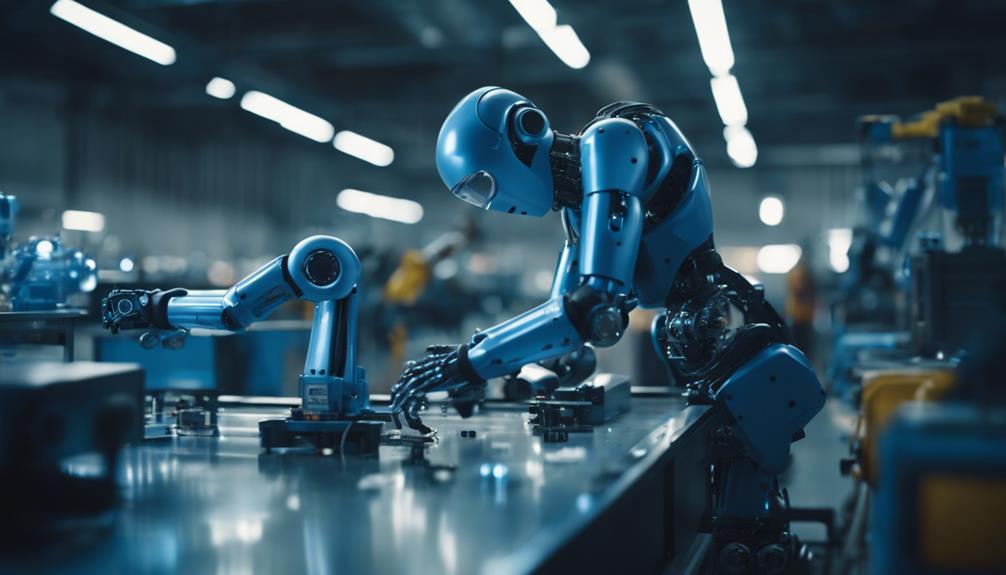
Maximizing Industry Growth Through Robotics Integration
June 21, 2024As you consider incorporating robotics into your operations, you'll access unprecedented levels of efficiency, productivity, and precision, setting your business on a trajectory for sustainable growth and competitiveness. By automating tasks, you'll boost productivity, reduce labor costs, and enhance quality and consistency in manufacturing processes. With robotics, you'll also improve safety by delegating dangerous tasks to robots. To overcome integration challenges, you'll need to assess current processes, partner with experienced integrators, and conduct thorough testing. Now, take the first step toward maximizing industry growth – explore the world of robotics integration and discover its full potential.
Robotics Integration Essentials
When integrating robotics into your manufacturing process, it's crucial to comprehend the essential components that make a successful implementation. You'll need to examine the industrial context in which you're operating, and how automation can enhance your production capabilities. This is where customized solutions come into play, as they enable you to tailor your robotic technology to meet specific needs.
In today's manufacturing landscape, robotic integration is no longer a luxury, but a necessity. With the global industrial robots market projected to exceed $35 billion by 2029, it's evident that this technology is here to stay.
To maximize the benefits of robotics integration, you'll need to partner with an experienced integrator who can provide customized solutions that cater to your unique needs. By doing so, you'll be able to leverage the full potential of robotic technology, boosting your productivity and competitiveness in the process.
Boosting Efficiency With Robots
As you explore the benefits of robotics integration, you'll discover that optimized production lines, enhanced task automation, and streamlined workflows are within your reach.
By implementing robots in your operations, you'll be able to maximize efficiency and reduce costs.
Optimized Production Lines
By incorporating robots into your production lines, you can boost efficiency by operating 24/7, increasing productivity and reducing labor costs. Robotics integration streamlines tasks like material handling, welding, and assembly, enhancing quality and safety standards in manufacturing. This leads to improved efficiency, reduced labor costs, and a safer work environment, maximizing industry growth potential.
Here are some key benefits of optimized production lines:
- Consistent Quality: Robots guarantee consistent quality, precision, and repeatability, improving overall product output.
- Enhanced Workplace Safety: Industrial robots handle dangerous tasks, enhancing workplace safety and compliance with regulations.
- Increased Productivity: Robotics integration boosts productivity by automating repetitive and labor-intensive tasks.
- Reduced Labor Costs: By taking over tasks that were previously done by humans, robots decrease labor costs and improve overall efficiency.
Enhanced Task Automation
You can supercharge your manufacturing process with robots, which take over repetitive and labor-intensive tasks, freeing up your workforce to focus on higher-value activities that drive innovation and growth.
By integrating automation technology, you can enhance task automation, leading to a 24/7 operation capability. This means you can produce more with less, as robots take over manual labor tasks, reducing costs and increasing efficiency.
With robotic integration, you can achieve improved precision and consistency in tasks, ensuring high-quality products. Additionally, robots can handle dangerous tasks, improving workplace safety in industrial operations.
By automating tasks, you can redirect your workforce to focus on strategic planning, research, and development, leading to enhanced productivity.
With robotic integration, you can streamline material handling and welding processes, further boosting efficiency. By leveraging the power of robotics, you can revolutionize your manufacturing process, driving growth and competitiveness in your industry.
Streamlined Workflows
Streamlining workflows with robots enables manufacturers to boost efficiency by offloading tedious, error-prone tasks, freeing up personnel to tackle high-value activities that drive innovation and growth.
By integrating robots into your workflow, you can:
- Eliminate human error: Robots can perform repetitive tasks with precision and accuracy, reducing the likelihood of mistakes and defects.
- Increase productivity: Efficient robotic systems can operate 24/7, greatly boosting productivity in manufacturing processes.
- Minimize downtime: Automation through robotics integration minimizes production downtime, leading to enhanced operational efficiency.
- Improve task accuracy: Robots in workflows improve task accuracy, ensuring consistent quality in manufacturing output.
Overcoming Integration Challenges

As you start incorporating robotics into your industrial operations, technical hurdles inevitably arise, necessitating the expertise of skilled integrators to overcome them. Robotic integration can be intricate, and industrial robotics requires careful calibration to guarantee seamless integration.
Technical challenges can be intimidating, but with the right expertise, you can overcome them.
To manage costs effectively, consider financing options that can help spread the cost of integration over time. This can help alleviate the financial burden of integrating industrial robotics into your operations.
Additionally, employee resistance to robotics can be addressed through thorough training programs, ensuring a smooth shift to automated workflows.
Robotics in Modern Manufacturing
As you explore the role of robotics in modern manufacturing, you'll find that efficient production lines, automated quality control, and streamlined assembly processes are just a few areas where robots are making a significant impact.
By automating these tasks, manufacturers can reduce errors, increase output, and improve overall product quality.
Efficient Production Lines
By incorporating robots into your production lines, you can greatly enhance efficiency, precision, and productivity, ultimately revolutionizing your manufacturing processes. With automation systems taking over repetitive and labor-intensive tasks, you can increase productivity and reduce labor costs. This, in turn, allows you to optimize resource management and allocate resources more efficiently.
Here are some key benefits of integrating robots into your production lines:
- Improved operational speed: Robots can work around the clock, increasing production volume and reducing lead times.
- Enhanced quality control: Robots can perform tasks with high precision and repeatability, ensuring consistent quality and customer satisfaction.
- Increased safety standards: Robots can handle dangerous tasks, reducing the risk of accidents and improving overall safety in the manufacturing environment.
- Streamlined resource management: With robots taking over routine tasks, you can allocate resources more efficiently, reducing waste and improving overall efficiency.
Automated Quality Control
In modern manufacturing, you can greatly enhance product quality and accuracy by leveraging robotics for automated quality control, guaranteeing consistent results and minimizing defects.
By integrating robotics into your quality control processes, you can substantially reduce errors and improve efficiency. Robots equipped with advanced sensors and AI technology can detect defects with high precision, improving overall product quality.
Automation in quality control minimizes human error, leading to higher levels of reliability and repeatability in manufacturing. This, in turn, increases productivity, reduces waste, and streamlines manufacturing processes.
With robotics integration, you can make sure that your products meet the highest standards of quality, every time. By implementing automated quality control systems, you can focus on other critical aspects of your business, knowing that your products are being manufactured to perfection.
Streamlined Assembly Processes
You can now take your manufacturing operations to the next level by streamlining assembly processes with robotics, a natural extension of the quality control advancements you've already made. By integrating robotics into your assembly processes, you'll experience a significant boost in efficiency and productivity.
Here are just a few ways robotics integration can benefit your assembly processes:
- Automated tasks: Robotics can automate tasks such as part transfer, machine loading, and assembly, freeing up human workers to focus on higher-value tasks.
- Improved accuracy: Robots can perform tasks with precision and consistency, reducing errors and improving overall product quality.
- Enhanced workplace safety: By handling heavy materials and performing tasks that pose a risk to human workers, robots can greatly improve workplace safety.
- Increased productivity: With robots handling repetitive and labor-intensive tasks, you'll see a significant increase in productivity and output.
Collaborative Robots in Action

As manufacturers seek to boost efficiency and productivity, collaborative robots are increasingly being deployed on the factory floor to work alongside human workers. You're likely to see these robots, also known as cobots, performing a variety of tasks, from assembly and pick-and-place operations to quality inspection.
What makes cobots so versatile is their ability to work safely alongside humans, thanks to built-in sensors and safety mechanisms that eliminate the need for safety barriers. This human-robot collaboration enables industrial automation like never before.
As a result, you can expect to see cobots being used in a wide range of applications, from small and medium-sized enterprises to large-scale industrial operations. The cost-effectiveness and ease of programming of cobots make them an attractive solution for businesses of all sizes.
With the market for collaborative robots growing rapidly, it's clear that these robots are here to stay – and will play a key role in driving industry growth in the years to come.
Safety First in Robotics
As you integrate robotics into your industry, you'll want to prioritize safety protocols to guarantee a hazard-free environment.
You'll need to implement risk assessment protocols, enable robot collision detection systems, and facilitate seamless human-robot collaboration.
Risk Assessment Protocols
To guarantee a safe working environment, risk assessment protocols must be integrated into robotics integration to identify and mitigate potential hazards. As you implement robotics integration, it's important to prioritize safety to avoid accidents and comply with safety regulations.
To achieve this, you'll need to conduct thorough risk assessments to identify potential hazards related to mechanical, electrical, and software components of robotic systems.
Here are some key considerations:
- Safety standards: Adhere to guidelines like ISO 10218 and ANSI/RIA R15.06 to make sure your risk assessment protocols meet industry standards.
- Failure modes and effects analysis (FMEA): Use this methodology to identify and mitigate potential failures in robotic operations.
- Component evaluation: Assess the risks associated with individual components, such as mechanical parts, electrical systems, and software.
- Employee training: Ensure that operators and maintenance personnel are trained to handle robotic systems safely and respond to emergencies effectively.
Robot Collision Detection
By incorporating robot collision detection systems into your robotic integration, you can greatly reduce the risk of accidents and equipment damage. This technology is essential in ensuring workplace safety, as it prevents collisions that can lead to injuries and costly repairs.
Robot collision detection systems rely on advanced sensors, such as LiDAR, cameras, and proximity sensors, to detect obstacles and prevent accidents. In fact, the global market for industrial robots' safety systems was valued at over $1 billion in 2019, highlighting the importance of collision detection in robotics integration.
Implementing collision detection systems in your robotics integration can have a significant impact on your operations. By minimizing the risk of accidents, you can reduce downtime and maintenance costs associated with equipment damage. This means you can focus on increasing productivity and efficiency, ultimately contributing to your industry's growth.
Human-Robot Collaboration
You can greatly enhance workplace safety in your industry by introducing human-robot collaboration, which reduces risks associated with dangerous tasks and promotes a safe working environment. This collaboration is made possible through the use of collaborative robots (cobots) designed to work alongside humans.
To guarantee safe interactions, safety measures such as sensors, safety barriers, and force-limiting technologies are implemented.
To guarantee a safe and successful human-robot collaboration, it's crucial to:
- Conduct thorough risk assessments to identify potential hazards.
- Establish and communicate clear safety protocols to all personnel.
- Provide detailed training programs for employees working alongside robots.
- Adhere to safety standards such as ISO 10218 and ISO/TS 15066, which regulate human-robot interactions to prevent accidents and injuries.
The Future of Industrial Robots

As the global robotics market is poised to reach $160-260 billion by 2030, industrial robots are expected to take on more complex and autonomous tasks, revolutionizing the manufacturing landscape. You can expect to see significant advancements in industrial robotics, with robots performing end-to-end tasks, enhancing efficiency and productivity.
Collaborative robots, designed to work alongside humans without safety fencing, will become more prevalent, improving workplace safety and efficiency. Investments in robotic arms have already shown a short payback period, highlighting a promising future for industrial robotics.
Automation and robotics will play a vital role in minimizing human contact, reflecting the industry's focus on safety and efficiency. As you integrate robots into your manufacturing process, you'll be poised to reap the benefits of increased productivity, reduced costs, and improved product quality.
With the future of industrial robots looking brighter than ever, it's imperative to stay ahead of the curve and capitalize on the opportunities presented by this rapidly evolving industry.
Industry Applications of Robotics
Across various industries, robotics integration is transforming the way businesses operate, with enhanced productivity and efficiency being the hallmark of this technological revolution. As you explore the applications of robotics, you'll discover its impact on multiple sectors.
In manufacturing, robotic applications are utilized in tasks such as material handling, welding, and assembly, leading to improved precision and consistency. In healthcare, robotics integration enables improved accuracy in surgeries and increased success rates in sensitive medical procedures.
Here are some key industry applications of robotics:
- Automotive manufacturing: Robotics integration in automotive manufacturing improves precision and efficiency in production processes, leading to higher quality vehicles.
- Healthcare: Robotics in healthcare enables improved accuracy and reduced harm to surrounding tissues in surgeries.
- Agriculture: Robotics integration in agriculture leads to increased output, cost reduction, and enhanced efficiency in farming practices.
- Logistics: Automated guided vehicles, powered by artificial intelligence, optimize warehouse operations and streamline supply chains.
Robotics Integration Best Practices

To ensure a smooth shift to robotics integration, manufacturers must first assess their current processes, identifying areas where automation can maximize efficiency and productivity. This involves evaluating your current labor costs and determining how robotic systems can reduce them.
When designing custom robotic systems, partnering with experienced integrators who possess technical expertise and strong relationships with robotics manufacturers is crucial. They'll help you navigate the system integration process, ensuring a seamless move to automated systems.
Thorough testing is also critical to identify and address any technical issues before implementation. By following these best practices, you'll be able to harness the benefits of robotics integration, including increased productivity, improved quality, and enhanced safety in your manufacturing operations.
With the right integrator and a well-planned approach, you can overcome common challenges like employee resistance and system calibration, maximizing the advantages of robotics integration for your industry.
Unlocking Growth With Robotics
By implementing robotics integration, you can access significant growth opportunities in your manufacturing operations. This involves leveraging the benefits of increased productivity, reduced labor costs, and improved quality and safety.
With robotics integration, you can:
- Boost productivity: Enable 24/7 operation and maximize output with automation.
- Reduce labor costs: Automate tasks and minimize labor expenses.
- Enhance quality and consistency: Guarantee precision and accuracy in manufacturing processes.
- Improve safety: Delegate dangerous tasks to robots, creating a safer work environment.
Conclusion
You've seen how robotics integration can revolutionize your industry. By adopting robots, you can boost efficiency, overcome challenges, and enhance growth.
Did you know that 80% of companies that have adopted robotics have seen increased productivity? It's no wonder robotics is expected to become a $190 billion industry by 2025.
By embracing robotics integration best practices, you can stay ahead of the curve and maximize industry growth.


